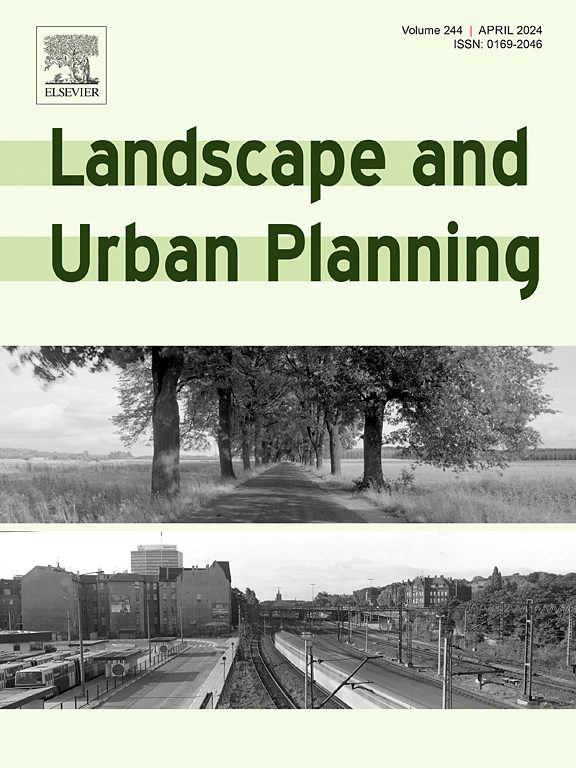A satellite perspective of interannual and seasonal variations in greenspace and human exposure over urban and peri-urban areas in Chinese cities from 2000 to 2020
IF 7.9
1区 环境科学与生态学
Q1 ECOLOGY
引用次数: 0
Abstract
Urban greenspaces significantly influence the ecological environment, resident health, and sustainable development of cities. Fractional vegetation cover (FVC) is a common measure of urban greenspace, and a long-term FVC dataset is required to characterize the dynamics of vegetation in a complex urban environment along with socioeconomic development. This study proposed a data fusion method to integrate multiple existing satellite-based FVC datasets to create a spatially and temporally seamless FVC dataset at a 30-m resolution, which was applied to urban greenspace mapping for 12 representative cities in China for the 2000–2020 period. In addition, the distribution and changes in the equality of urban greenspaces exposure during the study period were examined by integrating the 30-m FVC datasets with a population-weighted exposure framework. Greendays are defined as the annual duration for which urban residents enjoy greenery throughout the year. The results suggest that greenspace in the 12 cities showed an upward trend, with greendays displaying a slight overall extension. The magnitude of the increase in greenspace and greendays was generally greater in peri-urban areas than in core urban areas. Equality in urban greenspace exposure remained high and improved over time. This research offers essential data support for urban planners and policymakers, contributing to more informed management of urban greenspaces. By mapping the evolution of greenspace exposure, this research supports decision-making towards a more equitable, healthy urban environment, aligning with the United Nations Sustainable Development Goals focused on health, well-being, and sustainable urbanization.
2000 - 2020年中国城市和城郊绿地和人类暴露年际和季节变化的卫星视角
城市绿地对生态环境、居民健康和城市可持续发展具有重要影响。植被覆盖度(Fractional vegetation覆盖度,FVC)是衡量城市绿地面积的常用指标,需要一个长期的植被覆盖度数据集来描述复杂城市环境中随着社会经济发展而变化的植被动态特征。本研究提出了一种数据融合方法,将多个现有的卫星植被覆盖度数据集整合在一起,构建了一个30 m分辨率的空间和时间无缝的植被覆盖度数据集,并应用于2000-2020年中国12个代表性城市的城市绿地制图。此外,通过将30 m植被覆盖度数据集与人口加权暴露框架相结合,考察了研究期间城市绿地暴露平等性的分布和变化。绿色日被定义为城市居民全年享受绿色的时间。结果表明:12个城市绿地面积总体呈上升趋势,绿地面积总体略有扩大;城市周边地区绿地面积和绿化天数的增加幅度普遍大于核心城市地区。城市绿地暴露的公平性仍然很高,并随着时间的推移而改善。该研究为城市规划者和决策者提供了必要的数据支持,有助于更明智地管理城市绿地。通过绘制绿色空间暴露的演变图,本研究支持朝着更公平、更健康的城市环境做出决策,与关注健康、福祉和可持续城市化的联合国可持续发展目标保持一致。
本文章由计算机程序翻译,如有差异,请以英文原文为准。
求助全文
约1分钟内获得全文
求助全文
来源期刊

Landscape and Urban Planning
环境科学-生态学
CiteScore
15.20
自引率
6.60%
发文量
232
审稿时长
6 months
期刊介绍:
Landscape and Urban Planning is an international journal that aims to enhance our understanding of landscapes and promote sustainable solutions for landscape change. The journal focuses on landscapes as complex social-ecological systems that encompass various spatial and temporal dimensions. These landscapes possess aesthetic, natural, and cultural qualities that are valued by individuals in different ways, leading to actions that alter the landscape. With increasing urbanization and the need for ecological and cultural sensitivity at various scales, a multidisciplinary approach is necessary to comprehend and align social and ecological values for landscape sustainability. The journal believes that combining landscape science with planning and design can yield positive outcomes for both people and nature.
 求助内容:
求助内容: 应助结果提醒方式:
应助结果提醒方式:


